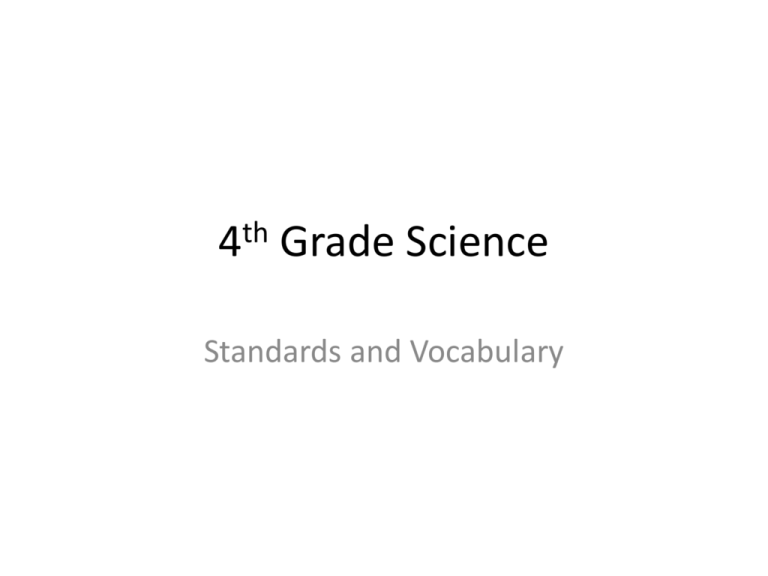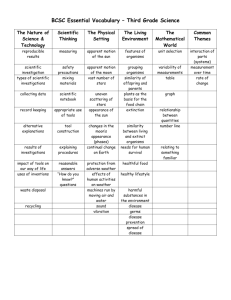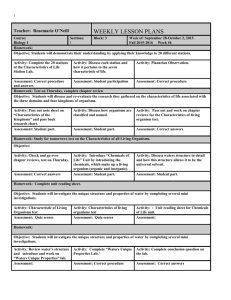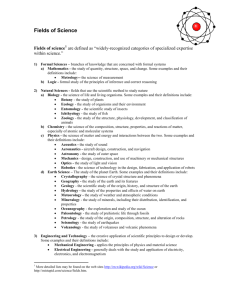Vocabulary
advertisement

th 4 Grade Science Standards and Vocabulary Scientific Investigations & Reasoning: Lab Safety • • • (4.1) The student conducts classroom and outdoor investigations, following home and school safety procedures and environmental appropriate and ethical practices. The student is expected to: A. demonstrate safe practices and the use of safety equipment as described in the Texas Safety Standards during classroom and outdoor education investigations; B. make informed choices in the use and conservation of natural resources and reusing and recycling of materials such as paper, aluminum, glass, cans, and plastic. Vocabulary Safety Hazardous Conservation Disposal Recycling Precaution Waft Procedures Chemicals Equipment Scientific Investigations & Reasoning: Inquiry/Notebooking • • • • • • • (4.2) The student uses scientific inquiry methods during laboratory and outdoor education investigations. The student is expected to: A. plan and implement descriptive investigations, including asking well-defined questions, making inferences, and selecting and using appropriate equipment or technology to answer his/her questions. B. collect and record data by observing and measuring, using the metric system, and using descriptive words and numerals such as labeled drawings, writing, and concept maps; C. construct simple tables, charts, bar graphs, and maps using tools and current technology to organize, examine, and evaluate data; D. analyze data and interpret patterns to construct reasonable explanations from data that can be observed and measured; E. perform repeated investigations to increase the reliability of results; and F. communicates valid oral and written results supported by data. Vocabulary Notebook Journal table of contents Observations Data Reflection Diagram Labeling Scientific drawings Matter and Energy • • • • 4.5 Matter and Energy. The student knows that matter has measurable physical properties and those properties determine how matter is classified, changed, and used. The student is expected to: (A) measure, compare, and contrast physical properties of matter, including size, mass, volume, states of matter (solid, liquid, gas), temperature, magnetism, and the ability to sink or float; (B) predict the changes caused by heating and cooling such as ice becoming liquid water and condensation forming on the outside of a glass of water, and (C) compare and contrast a variety of mixtures and solutions such as rocks in sand, sand in water, or sugar in water. Vocabulary Texture substance state of matter buoyancy Gas physical state properties Liquid particle physical change Solid matter mass Buoyancy Volume Matter & Energy: Force, Motion, & Energy • • • • • 4.6 Force, motion, and energy. The student knows that energy exists in many forms and can be observed in cycles, patterns, and systems. The student is expected to: (A) differentiate among forms of energy, including mechanical, sound, electrical, light, and heat/thermal. (B) differentiate between conductors and insulators; (C) demonstrate that electricity travels in a closed path, creating an electrical circuit, and explore electromagnetic field and (D) design and experiment to test the effect of force on an object such as push or a pull, gravity, friction, or magnetism. Vocabulary Condensation Evaporation Mixture Dissolves Solution Evaporation Magnet magnetism attract repel Poles iron iron filings Earth & Space: Soil Properties • (4.7) Earth and space. The students know that Earth consists of useful resources and its surface is constantly changing. The student is expected to: • A. Examine properties of soil, including color and texture, capacity to retain water, and ability to support the growth of plants. Vocabulary Soil Silt Control Gravel Bedrock Topsoil Variable Absorb Humus Sediment Clay Retain Earth & Space: Weathering & Erosion • (4.7) Earth and space. The students know that Earth consists of useful resources and its surface is constantly changing. The student is expected to: • B. Observe and indentify slow changes to Earth’s surface caused by weathering, erosion, and deposition from water, wind, and ice; Vocabulary Weathering Erosion Deposition Earth & Space: Renewable and Nonrenewable Resources • (4.7) Earth and space. The students know that Earth consists of useful resources and its surface is constantly changing. The student is expected to: • C. identify and classify Earth’s renewable resources, including air, plants, water, and animals; and nonrenewable resources, including coal, oil, and natural gas; and the importance of conservation; Vocabulary Natural resources renewable nonrenewable Conservation Earth & Space: Weather • (4.8) Earth and space. The student knows that there are recognizable patterns in the natural world and among the Sun, Earth, and Moon system. The student is expected to: • A. measure and record changes in weather and make predictions using weather maps, weather symbols, and a map key; • B. describe and illustrate the continuous movement of water above and on the surface of the water of Earth through the water cycle and explain the role of the Sun as a major source of energy in this process; Vocabulary Air Clouds Cumulonimbus Nimbostratus Stratus Condensation Forecast Tornado Precipitation Weather Wind Meteorologist low tides Atmosphere Cirrus Cumulus Climate Fog Evaporation Hurricane Front Water cycle seasons Barometer high tides Earth & Space: Change Over Time • (4.8) Earth and space. The student knows that there are recognizable patterns in the natural world and among the Sun, Earth, and Moon system. The student is expected to: • C. collect and analyze data to identify sequences and predict patterns of change in shadows, tides, seasons, and the observable appearance of the Moon over time. Vocabulary Air Clouds Cumulonimbus Nimbostratus Stratus Condensation Forecast Tornado Precipitation Weather Wind Meteorologist low tides Atmosphere Cirrus Cumulus Climate Fog Evaporation Hurricane Front Water cycle seasons Barometer high tides Organisms & Environments Life Systems: Food Webs/Food Chains/Ecosystems • • • (4.9)Organisms and environments. The student knows and understands that living organisms within an ecosystem interact with one another and with their environment. The student is expected to: investigate that most producers need sunlight, water, and carbon dioxide to make their own food, while consumers are dependent on other organisms for food; and Describe the flow of energy through food webs, beginning with the Sun, and predict how changes in the ecosystem affect the food web such as a fire in a forest. Vocabulary Metamorphosis Animals Migrate Carnivore Needs Chrysalis Niche Compete Nymph Competition Omnivore Consumer Organism Cycle Population Cocoon Decomposer External features / structures Growth Predator Habitat Prey Herbivore Producer Hibernate Pupa Larva Species Survival System Organisms & Environments Life Systems: Adaptations for Plants/Animals • (4.10) Organisms and environments. The student knows that organisms undergo similar life processes and have structures that help them survive within their environment. The student is expected to: • A. explore how adaptations enable organisms to survive in their environment such as comparing bird’s beaks and leaves on plants; Vocabulary Metamorphosis Animals Migrate Carnivore Needs Chrysalis Niche Compete Nymph Competition Omnivore Consumer Organism Cycle Population Cocoon Decomposer External features / structures Growth Predator Habitat Prey Herbivore Producer Hibernate Pupa Larva Species Survival System Organisms & Environments Life Systems: Inherited Traits and Learned Behaviors • (4.10) Organisms and environments. The student knows that organisms undergo similar life processes and have structures that help them survive within their environment. The student is expected to: • B. demonstrate that some likenesses between parents and offspring are inherited, passed from generation to generation such as eye color in humans or shapes of leaves in plants. Other likenesses are learned such as table manners or reading a book and seals balancing balls on their noses; Vocabulary Adaptation Behavior Instinctive behavior Learned behavior Inherited trait Habitat Niche Camouflage Mimicry Exoskeleton Migration Structural adaptations Behavioral adaptations Organisms & Environments Life Systems: Life Cycles • (4.10) Organisms and environments. The student knows that organisms undergo similar life processes and have structures that help them survive within their environment. The student is expected to: • C. explore, illustrate, and compare life cycles in living organisms such as butterflies, beetles, radishes, or lima beans. Vocabulary Adaptation Behavior Instinctive behavior Learned behavior Inherited trait Habitat Niche Camouflage Mimicry Exoskeleton Migration Structural adaptations Behavioral adaptations






